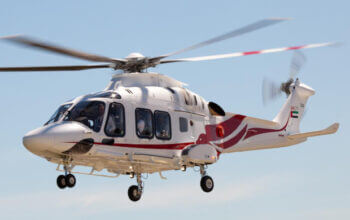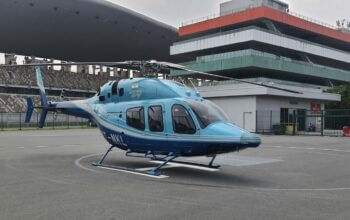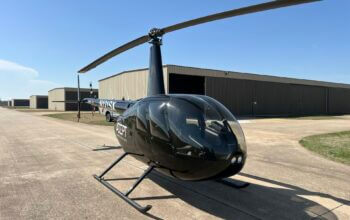Estimated reading time 16 minutes, 18 seconds.
Originally created as a relief airport for Calgary International, small-aircraft-focused Springbank has itself become an extremely busy and important part of the southern Alberta aviation landscape.
In 1969, Transport Canada purchased 1,040 acres of land, some 20 kilometres west of Calgary, Alta., and southeast of Cochrane, Alta., to build Springbank Airport (CYBW). The new airport was intended to relieve Calgary International of its flight training and other small aircraft traffic, to keep them from rubbing shoulders with the increasing number of commercial aircraft movements.
I first visited Springbank in 1970 (a year after it began operation, but a year before it officially opened) when it was a small, sleepy airfield to which the Calgary Flying Club had relocated, and to which Mount Royal College commercial pilot training program would soon follow. A few lean-to and T hangars had been built or were under construction, and a small number of general aviation (GA) aircraft were parked on the grass. Not too much changed during the next few years, but as Calgary International became less hospitable to GA aircraft, CYBW started to evolve. Gradually, it became the airport of choice for many small craft.
Migration and Change
As Springbank evolved, small aircraft maintenance organizations (AMOs) soon relocated there from Calgary International, most following their customers. However, Rocky Mountain Aircraft was one AMO that moved to take advantage of the room to grow. Helicopter companies also moved there, bringing additional technical facilities and rotary-wing training to the slowly expanding airfield.
In 1997, Transport Canada transferred operation of CYBW to the Calgary Airport Authority (CAA) and things really took off. As Alberta robust economy continued to boom, the number of new pilots purchasing aircraft created a need for more hangars at Springbank. More land south of runway 07/25 was developed by the airport and a construction boom followed. It seemed that every few months another hangar, AMO, training operation or support company would make its new home at the little airport with the million-dollar view of the Rocky Mountains.
Overseeing these boom years has been current airport general manager Larry Stock, who assumed this role in 1997. Not only has Stock overseen an era of rapid change and increased capabilities, he also has managed customer reactions to those changes, including the resulting increases in tenant lease rates.
To create a viable airport, we needed revenue, said Stock. The CAA contributed a significant amount, but the users were also asked to contribute to their airport. Increasing the lease rates has been an interesting challenge and a tough sell. There has been push-back from some of the leaseholders and businesses, but rates are far lower than in Calgary. It has been a balancing act to keep all parties satisfied while increasing capabilities at the same time, said Stock.
The biggest project in recent years was the expansion of runway 16/34 to 5,000 feet (1,524 metres). A VOR (VHF omni-directional radio range) was installed, but was only certified for training purposes. However, a non-precision DME/ILS (distance measuring equipment/instrument landing system) approach on runway 34 has been certified. Meanwhile, published GPS approaches to 16/34, precision approach pathway indicators on both 16/34 and 07/25, and upgraded runway lighting on 16/34 all provide landing guidance.
The new runway lighting has meant reduced visibility operations are now allowed for departures at a runway visual range of 1,200 feet (one-quarter statute miles) during daylight hours. And, all the navigation aids have resulted in a far more user-friendly airport for students, private pilots and commercial operations.
The navaids plus the addition of a customs clearance facility, meanwhile, opened up international travel to and from the United States. It took six years to get Canada customs [the Canada Border Services Agency] to agree to provide services at Springbank . . . . explained Stock. The addition of customs, navaids and lighting upgrades has resulted in a number of light business jets locating here and charter operations increasing.
To manage and direct future growth, a 20-year master development plan was created in 2009, but the recession has delayed many of the major expansion plans, including the building of a parallel runway (34L/16R), land development north of runway 07/25 and the lengthening of 07/25. The recession also has impacted flight operations: the total number of flights in 2010 was 146,000, down from a high of 221,000 in 2007. According to Stock, however, the 2011 numbers have been showing an increase, especially as the economy improves.
On the Field: The Trainers
Of course, an airport lifeblood comes from the companies that call it home. Among the dozens that inhabit Springbank, the Calgary Flying Club (CFC) is probably the oldest. CFC has been training pilots since 1927. Many of its students have gone on to become industry leaders, including heads of airlines. As one of the first to relocate to Calgary International when it was founded in 1938, it appropriately became one of the first to move to Springbank when it opened. Its original building at CYBW was replaced in 2004 by a new facility that has ample classrooms and flight planning space to provide pilot training that ranges from the recreational permit to multi-engine and instrument flight rules (IFR) add-ons.
The club is equipped with one [Cessna] C182, five [Cessna] C172s, four Diamond DV20s two with glass cockpits and two with traditional steam gauges a Piper PA-44-180T and a Precision Flight Controls modular flight deck simulator providing both single and multi-engine training, detailed chief flight instructor Tom Houston, himself a graduate of the club. The club has 500 active members and a membership of approximately 1,000. The club is a certified training institute, which allows the student access to government grants and a variety of other funding options.
Three part-time and 10 full-time instructors provide training for 240 active students pursuing permits, licences, and add-on ratings. Among the add-on ratings and courses available are night, mountain, multi-engine, IFR and visual-flight-rules over-the-top.
At the top end is its 10-month professional pilot course, which includes the multi-engine and IFR training. The professional pilot course consists of two semesters with students in the classroom in the morning and flying in the afternoon. Of course, getting a commercial licence does not guarantee a flying job immediately, so some graduates obtain an instructor qualification to help build hours. This is a common stepping stone to a flying job, stated Houston. We support their endeavours and know that in a few years they will leave to work their way up the career ladder as a professional pilot.
The Operators
One recent Springbank arrival is Central Aviation, an aircraft charter and corporate aircraft management firm. Originally headquartered in Wetaskiwin, Alta., some 260 kilometres north of Springbank, Central moved its main operation here four years ago and has been growing ever since.
Central core business is charter flights to the northern Alberta oil patch. Its main customers are the smaller resource companies located in Calgary, who it flies up to the oilfields with its two Piper PA-31 Navajos, a Piper PA-34 Seneca and a Cessna 500.
Central new facility, completed just this summer, features a 12,000-square-foot hangar, 3,500 square feet of office space and two smaller hangars for tenants. While not a fixed-based operation, the facility leases office space and provides fuel for its own and tenants’ aircraft. A large ramp and ample free parking, meanwhile, make the charter service very attractive to companies located in the Calgary core who wish to avoid road and air traffic congestion, plus the hassle of flying in and out of a major airport. Central advertises a 90-minute response time from an initial call to wheels-up: an important capability as downtime in the oil patch can be very costly.
We really like Springbank, said Central general manager, Colin MacLeod. There are no delays, departure slots, holds or issues compared to Calgary International. For us and our customers, this is a much better location. Many of Central customers send crews and parts out of Calgary to their oil-field operations in northern Alberta. The recession slowed down everybody, but our business is now up 25 per cent over 2010.
The Support Companies
Among the large number of service and support companies at Springbank are custom flight training, air medical services and maintenance organizations. The largest AMO is Rocky Mountain Aircraft, which has approximately 60 employees. Rocky Mountain specializes in the repair, overhaul and leasing of de Havilland DHC-6 Twin Otters, but also provides salvage and reconstruction for other piston- and turbine-powered aircraft up to a gross weight of 5,700 kilograms (12,560 pounds). Avionics modifications and repairs, unique company developed supplemental type certificates and a variety of other custom-designed modifications are also available.
A number of smaller AMOs provide fixed-wing repair services for most of the GA aircraft who live at Springbank or are flown in from outlying locations. Cavalier Aviation Ltd. is one of those AMOs, and has been providing GA aircraft maintenance services for some 30 years.
In 2004, current president Peter Verhesen purchased the company and has steadily added to its capabilities. We are a Cessna and Mooney aircraft and Lycoming service centre, stated Verhesen. We provide warranty and service parts to Cessna customers throughout Alberta, eastern B.C. and the Northwest Territories.
Cavalier is one of only four authorized Cessna propeller service facilities (covering all four prop categories: single-engine, multi-engine, turboprop and Caravan) in Canada and the only one in Alberta. Cavalier also has a Cessna mobile service unit (MSU) and can provide on-location service within a day drive of Springbank. The MSU is a truck equipped with a small crane for engine changes and a host of parts and tooling. The MSU is part of Cessna service direct program and focuses on Cessna
Citation jet line. Although Cavalier is not a Citation service centre, it is able to provide Citation service via service direct, while all customer scheduling and work orders get processed through the Sacramento, Calif., Citation service centre.
Other services Cavalier offers include Garmin avionics installations; annual pitot static certification, including reduced vertical separation minimums; emergency locator transmitter re-certification; sheet metal repairs; and aircraft importation. Cavalier also provides all the maintenance for Springbank Air Training College, a certified Cessna pilot centre.
Some of the Other Players
The helicopter industry is well represented on the field at Springbank, too. Chinook Aviation provides major and minor structural repairs (see p.50, Vertical, Apr-May 2011). Mountain View Helicopters provides training, tours and charter operations (see p.50, Vertical, Dec’08-Jan’09). And, Great Slave Helicopters provides light and medium-sized helicopter charter services, in addition to flight training (see p.74, Vertical, Apr-May 2009).
Of course, by far the biggest tenant group at Springbank is represented by GA aircraft and owners. There are several hundred small, private aircraft here. Some fly regularly, others seldom. A wide variety of makes and models make up the collective: one hangar could hold the latest GA model or a light business jet; another a warbird or a restored Cessna L-19; a third, an open-cockpit biplane. Some are simply the resting place of homebuilt aircraft that have been under construction for many years.
No matter what small aircraft or helicopter you fly, Springbank is the airport for all.
Gary Watson has decades of hands-on experience in both fixed and rotary-wing aviation maintenance. He recently retired from SAIT Polytechnic in Calgary, Alta., where he had taught avionics and human factors for many years. He can be reached at gary@verticalmag.com.
Notice a spelling mistake or typo?
Click on the button below to send an email to our team and we will get to it as soon as possible.
Report an error or typoHave a story idea you would like to suggest?
Click on the button below to send an email to our team and we will get to it as soon as possible.
Suggest a story














